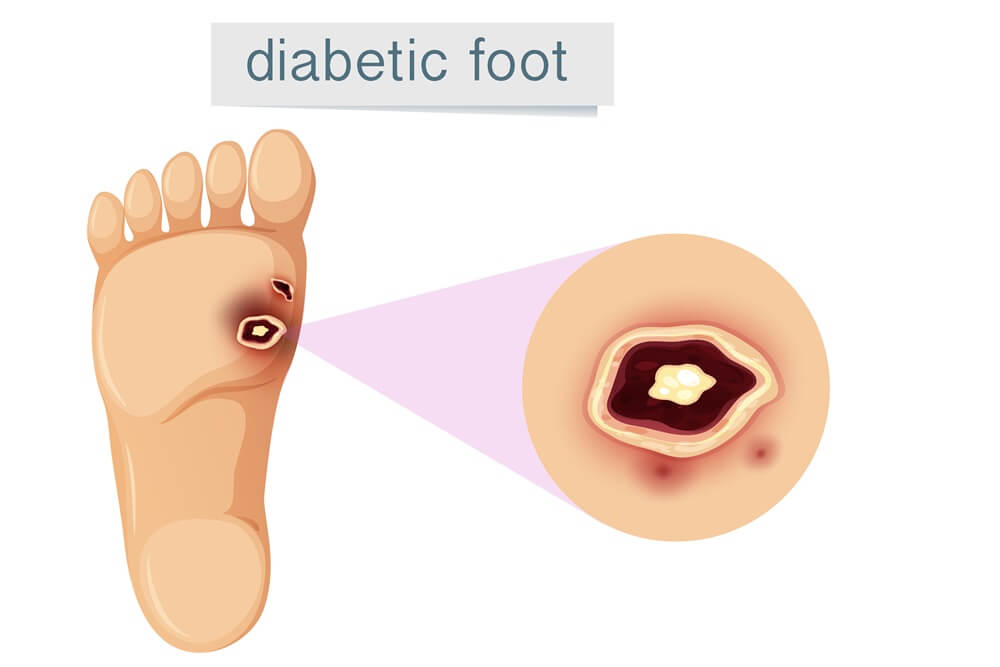
Diabetic foot (Diabetic Foot) is changes that affect the foot of a person suffering from diabetes as one of the complications caused by this disease due to nerve damage in the foot and decreased blood supply to the foot.
Causes of Diabetic Foot
A person develops diabetic foot due to high blood sugar levels and inadequate control among those affected by diabetes, which may lead to damage to the nerves of the lower limbs (diabetic neuropathy), and damage to blood vessels in the limbs, resulting in decreased blood circulation to the limbs.
Risk Factors for Diabetic Foot
The likelihood of developing diabetic foot in diabetic patients increases in the following cases:
-
Poor control of blood sugar levels for long periods.
-
Appearance of calluses (thickened and hardened layers of skin).
-
Foot deformities.
-
Neglecting foot care properly.
-
Wearing inappropriate shoes.
-
Dry skin.
-
Overweight or obesity, where a person's body mass index exceeds 25.
-
Presence of other medical conditions accompanying diabetes, such as nerve problems, high blood pressure, or high cholesterol.
-
Smoking.
-
Age, where individuals over 40 are more prone to diabetic foot.
Symptoms of Diabetic Foot
Symptoms of diabetic foot can include:
-
Numbness, tingling, or tingling sensation in the foot.
-
Foot pain.
-
Change in the shape and texture of the foot, making it pale and smooth.
-
Loss of hair in the affected foot.
-
Loss of sensation in the foot.
-
Swelling of the foot.
-
Failure of foot wounds to heal.
-
Lack of sweating from the foot.
-
Feeling of cramps in the leg.
-
Feeling of warmth upon touching the affected foot compared to the unaffected one.
-
Appearance of wounds, blisters, and ulcers on the foot.
-
Gangrene, an advanced stage of diabetic foot where the foot appears black, occurs due to delayed treatment of diabetic foot wounds and ulcers.
Diagnosis of Diabetic Foot
Diabetic foot is diagnosed clinically by examining the visible symptoms on the foot along with measuring the pulse in it to assess blood circulation to it. The doctor usually does this after taking the medical history and asking about any changes in the foot. The doctor may also need to perform the following tests:
-
Blood tests: which include checking blood sugar levels, in addition to other tests to rule out any infections.
-
X-ray imaging of the foot: to detect any damage to the bone or internal tissues due to diabetic foot.
Treatment of Diabetic Foot
The treatment of diabetic foot aims to control the associated symptoms and avoid complications that may occur if left untreated, and this is done through the following:
Medical and conservative treatment
A person with diabetic foot should undergo regular visits to a diabetic foot specialist, who does the following:
-
Clean any wounds on the foot.
-
Drain accumulated fluids or pus in foot ulcers.
-
Remove dead skin and infected tissues.
-
Apply special creams and dressings for diabetic foot to absorb fluids and protect wounds to help them heal.
-
Administer oral or intravenous antibiotics to treat any infections affecting diabetic foot.
Surgical treatment for diabetic foot
The doctor may resort to some surgical solutions for diabetic foot if necessary, including the following:
-
Removal of ingrown nails, which are nails that grow inside the soft tissues of the foot.
-
Surgery to treat deformities or changes that have occurred in the foot bones and toes, known as Charcot foot.
-
Creating an arterial bypass in the foot or installing a stent in one of the foot's arteries to improve blood flow to the diabetic foot.
-
Amputation of the affected toe or foot, which is the last resort that the doctor resorts to in case of severe complications of diabetic foot.
It is also necessary to comply with diabetes treatments to control its levels and treat any other health problems affecting the diabetic patient.
Prevention of Diabetic Foot
A diabetic patient can reduce the chances of developing diabetic foot by following the following advice:
-
Monitor the feet daily for any of the mentioned symptoms.
-
Wash the feet daily and dry them well, especially between the toes.
-
Use a moisturizer for the feet, especially in the ankle area, but it is advisable to avoid using it between the toes.
-
Use comfortable and appropriate shoes for the foot, and avoid open-toed shoes.
-
Quit smoking.
-
Follow a diet that includes increasing the portion of vegetables and fruits, and reducing sugar and salt.
-
Exercise for 10-20 minutes daily.
